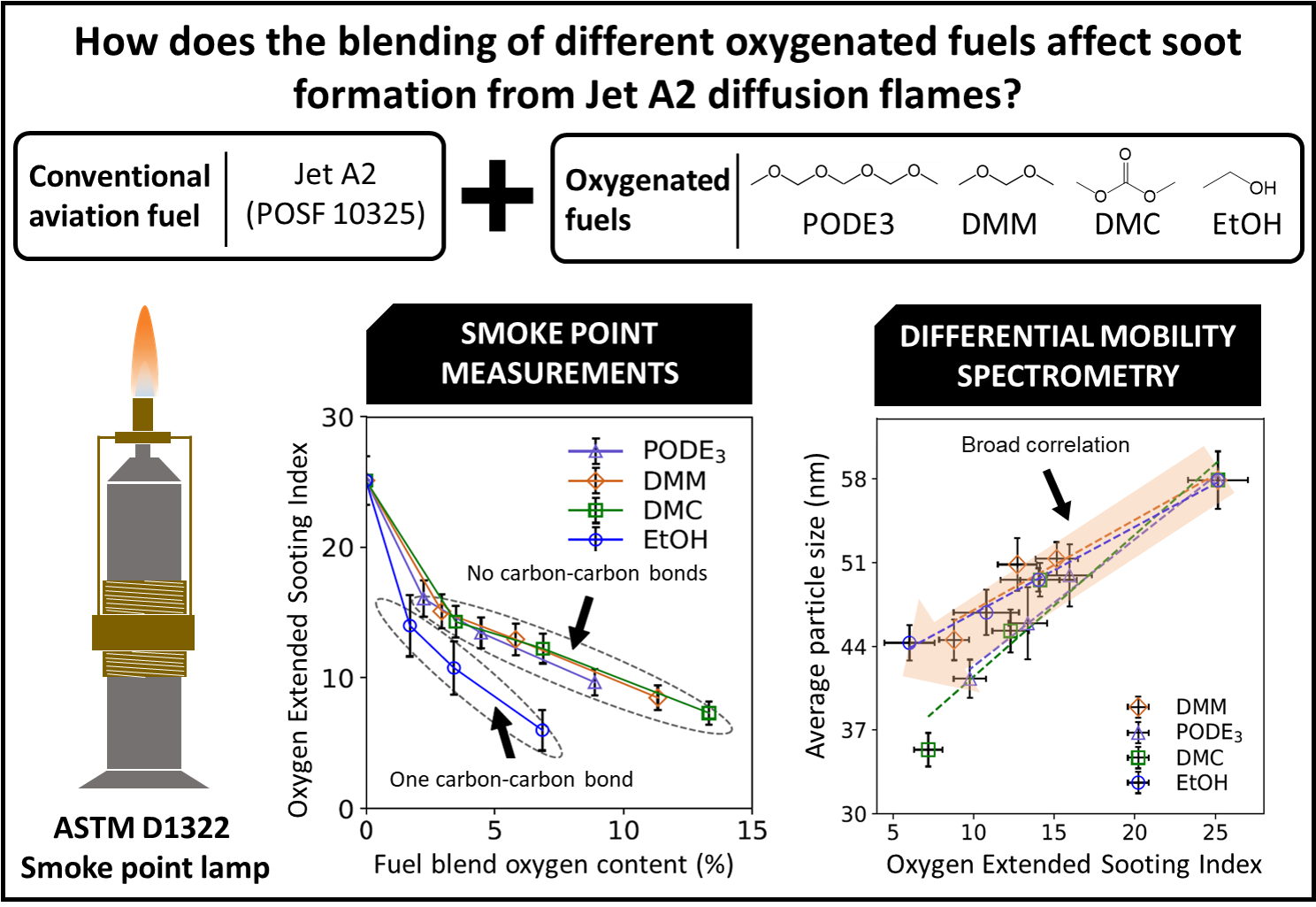Technical Report 274, c4e-Preprint Series, Cambridge
How does blending oxygenated fuels affect soot formation from Jet A2 diffusion flames?
Reference: Technical Report 274, c4e-Preprint Series, Cambridge, 2021
- PSDs and soot volume fraction of Jet A2 flame were reported for the first time
- Good correlations of OESI with PSDs and soot volume fraction were observed
- Structural effect of oxygenated fuel important in determining sooting tendency
 Four oxygenated fuels: ethanol (EtOH), dimethyl carbonate (DMC), dimethoxy-methane (DMM) and polyoxymethylene dimethyl ether (PODE3) were blended with Jet A2 to investigate the sooting behaviour of the fuel mixtures. The smoke point was measured using wick-fed laminar diffusion flames as per the ASTM D1322 standard. The oxygen extended sooting index (OESI) was calculated to determine the sooting tendency of each mixture. Colour-ratio pyrometry and differential mobility spectrometry were used to measure the soot volume fraction (fv) and particle size distribution (PSD). The addition of oxygenated fuels caused a strong reduction in sooting tendency (i.e. OESI) at low blend strengths (5%) and a weaker linear reduction at higher blend strengths (10% and 20%). Each mixture showed a similar reduction at a given mole fraction of oxygenated fuel. The OESI broadly correlated with the soot volume fraction and particle size measurements. Increasing blend strengths resulted in smaller particles at the tip of the flame. The average particle size at the tip was influenced by the oxygen content but not the molecular structure of the oxygenated fuels, whereas the soot volume fraction in the wings was influenced by boththe molecular structure of the oxygenated fuels and the oxygen/carbon ratio of the mixture. For the first time, fv and PSD have been reported for flames produced using Jet A2 blends in an ASTM D1322 lamp. The ability to relate data gathered using the ASTM D1322 standard for the sooting behaviour of different mixtures is going to be increasingly important as the aviation industry seeks to switch to sustainable fuels.
Four oxygenated fuels: ethanol (EtOH), dimethyl carbonate (DMC), dimethoxy-methane (DMM) and polyoxymethylene dimethyl ether (PODE3) were blended with Jet A2 to investigate the sooting behaviour of the fuel mixtures. The smoke point was measured using wick-fed laminar diffusion flames as per the ASTM D1322 standard. The oxygen extended sooting index (OESI) was calculated to determine the sooting tendency of each mixture. Colour-ratio pyrometry and differential mobility spectrometry were used to measure the soot volume fraction (fv) and particle size distribution (PSD). The addition of oxygenated fuels caused a strong reduction in sooting tendency (i.e. OESI) at low blend strengths (5%) and a weaker linear reduction at higher blend strengths (10% and 20%). Each mixture showed a similar reduction at a given mole fraction of oxygenated fuel. The OESI broadly correlated with the soot volume fraction and particle size measurements. Increasing blend strengths resulted in smaller particles at the tip of the flame. The average particle size at the tip was influenced by the oxygen content but not the molecular structure of the oxygenated fuels, whereas the soot volume fraction in the wings was influenced by boththe molecular structure of the oxygenated fuels and the oxygen/carbon ratio of the mixture. For the first time, fv and PSD have been reported for flames produced using Jet A2 blends in an ASTM D1322 lamp. The ability to relate data gathered using the ASTM D1322 standard for the sooting behaviour of different mixtures is going to be increasingly important as the aviation industry seeks to switch to sustainable fuels.
Material from this preprint has been published in Combustion and Flame.
PDF (3.3 MB)



